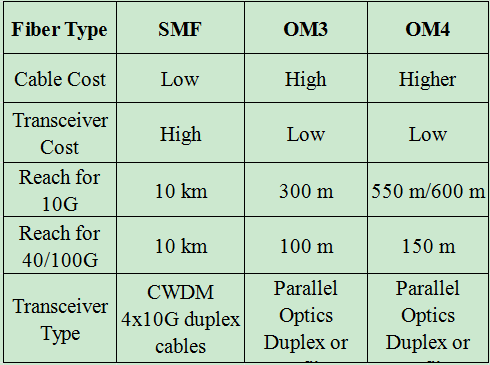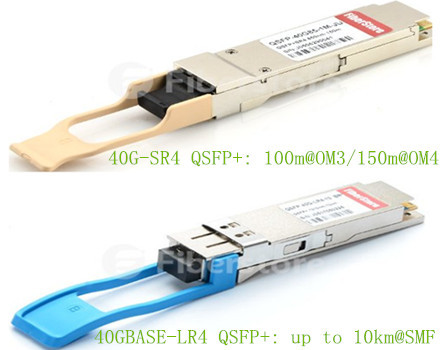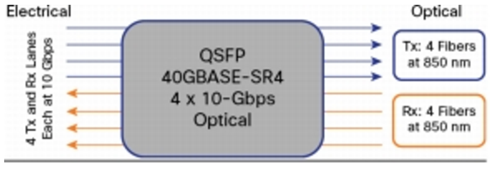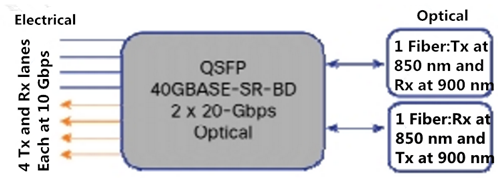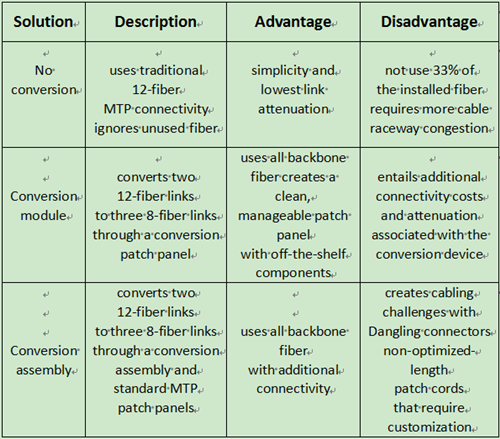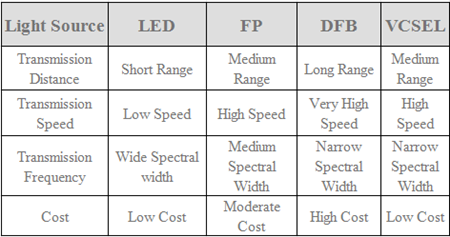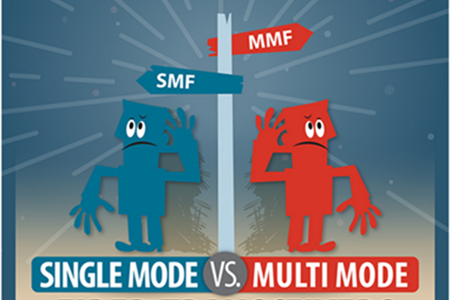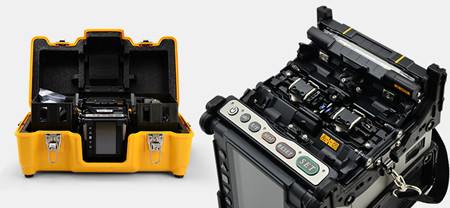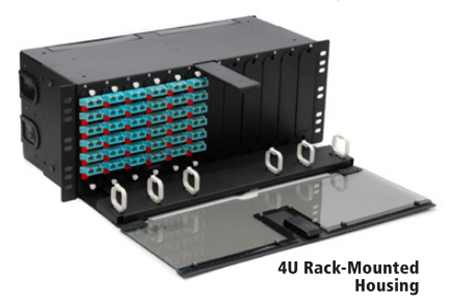40G network has replaced 10G lately and used worldwide, under this circumstance, 40G equipment like 40G transceivers and QSFP+ cables are required. Plan the cabling system in advance is the prerequisites to the designing of network system. The goal is to address current network requirements as well as accommodate future growth. There are two types of cabling solutions for 40G—structured cabling and unstructured cabling. This article will mainly introduced these two cabling solutions to you.
What Is Structured Cabling?
Structured cabling specified by the EIA/TIA TR42 committee, is the standardized architecture and component for communication cabling. In a structured cabling system, a series of patch panels and trunks are used to create a structure that allows for hardware ports to be connected to a patch panel at the top of the rack (see in Figure 1). A structured cabling system provides a flexible cabling plan to address the commonly performed tasks of moving, adding, and changing the infrastructure as the network grows.
Structured cabling specified by the EIA/TIA TR42 committee, is the standardized architecture and component for communication cabling. In a structured cabling system, a series of patch panels and trunks are used to create a structure that allows for hardware ports to be connected to a patch panel at the top of the rack (see in Figure 1). A structured cabling system provides a flexible cabling plan to address the commonly performed tasks of moving, adding, and changing the infrastructure as the network grows.
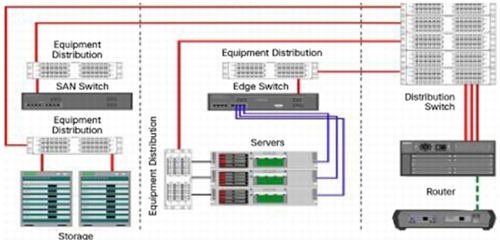
What Is Unstructured Cabling?
Unstructured cabling occurs when optical links are deployed point to point or device to device with no patch panels installed in the link. In this situation, cabling pathways become congested with an entangled mess of two-fiber optical patch cords (Figure 2). Likewise, routing new patch cords in ceiling or floor trays all the way across a data center each time a new device is deployed is extremely inefficient.
Unstructured cabling occurs when optical links are deployed point to point or device to device with no patch panels installed in the link. In this situation, cabling pathways become congested with an entangled mess of two-fiber optical patch cords (Figure 2). Likewise, routing new patch cords in ceiling or floor trays all the way across a data center each time a new device is deployed is extremely inefficient.
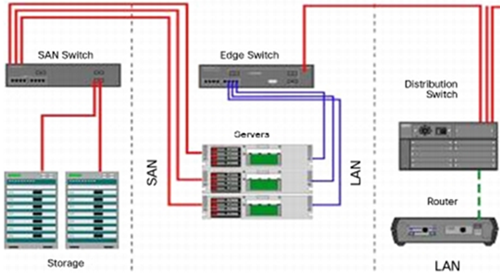
Structured or Unstructured Cabling System
As noted before, the difference between structured and unstructured cabling lies in the installation of patch panels. A good analogy for this is the electrical wiring in your home. When connecting appliances and devices, you require only a 5-foot connection to the closest electrical outlet. However, without an electrical outlet, all appliances would have to connect directly to the breaker or panel, requiring a cable of 200 feet or more. This approach would be inefficient and would become unmanageable as you add multiple appliances and devices throughout the home.
As noted before, the difference between structured and unstructured cabling lies in the installation of patch panels. A good analogy for this is the electrical wiring in your home. When connecting appliances and devices, you require only a 5-foot connection to the closest electrical outlet. However, without an electrical outlet, all appliances would have to connect directly to the breaker or panel, requiring a cable of 200 feet or more. This approach would be inefficient and would become unmanageable as you add multiple appliances and devices throughout the home.
Unstructured cabling like above point to point connectivity method can’t satisfy people’s needs any more. Because it may appear some mistakes in an unorganized messy cabling infrastructure. Remove a single cable from a large tangled mess can cause stress on the other cables. This stress can lead to network errors in the hardware that are very difficult to trace. Therefore, structured cabling becomes a necessity as the infrastructure grows and as constant moves and changes reinforce the need for a reliable network that is also easy to troubleshoot.
40G Structured Cabling Components
Laser-optimized multimode fiber, compared with single-mode fiber has proven itself to be the cost-effective cabling methods for high-data-rate system like 40GbE network, which has become the dominant fiber choice. Optimized for 850-nm VCSEL transceivers, these 50-micron fibers (especially OM3 and OM4) provide optimum technical and economic solution and become the dominant structured cabling options for today’s data centers. QSFP+ transceiver (typically with a 12-fiber MTP connector) is the dominant transceiver used for 40G applications. Other essential components for 40G structured cabling include MTP trunk cables, MTP-LC harness/breakout cables, LC or MTP patch cables, MTP-LC cassette modules, MTP adapter panels and MTP rack mount holders.
Laser-optimized multimode fiber, compared with single-mode fiber has proven itself to be the cost-effective cabling methods for high-data-rate system like 40GbE network, which has become the dominant fiber choice. Optimized for 850-nm VCSEL transceivers, these 50-micron fibers (especially OM3 and OM4) provide optimum technical and economic solution and become the dominant structured cabling options for today’s data centers. QSFP+ transceiver (typically with a 12-fiber MTP connector) is the dominant transceiver used for 40G applications. Other essential components for 40G structured cabling include MTP trunk cables, MTP-LC harness/breakout cables, LC or MTP patch cables, MTP-LC cassette modules, MTP adapter panels and MTP rack mount holders.
Conclusion
When deploying a network system, it is important to plan a cabling system in advance. Structured cabling uses fiber termination connector panels that are connected through permanent links of optical cabling, which is more popular than unstructured cabling. Fiberstore supplies a wide range of fiber optic transceivers and MTP/MPO assemblies such as MPO/MTP trunk cables, harness cables, cassette module and adapters. We also provide cost-effective 40G products including 40G QSFP and 40G cables. To satisfy your unique demands, we support custom or OEM service as well. For more information, please contact us directly
When deploying a network system, it is important to plan a cabling system in advance. Structured cabling uses fiber termination connector panels that are connected through permanent links of optical cabling, which is more popular than unstructured cabling. Fiberstore supplies a wide range of fiber optic transceivers and MTP/MPO assemblies such as MPO/MTP trunk cables, harness cables, cassette module and adapters. We also provide cost-effective 40G products including 40G QSFP and 40G cables. To satisfy your unique demands, we support custom or OEM service as well. For more information, please contact us directly

